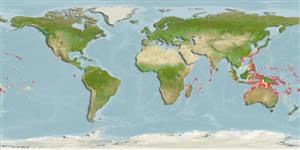Classification / Names
Common names from other countries
Main reference
Size / Weight / Age
Max length : 25.0 cm TL male/unsexed; (Ref. 5213)
Environment
Marine; reef-associated; depth range 1 - 43 m (Ref. 9710), usually ? - 25 m (Ref. 9710)
Climate / Range
Tropical, preferred ?; 32°N - 32°S
Distribution
Indo-West Pacific: south to Durban, South Africa, east to Marshall Islands. Recently reported from Tonga (Ref. 53797).
Countries | FAO areas | Ecosystems | Occurrences | Introductions
Short description
Dorsal
spines
(total): 2;
Dorsal
soft rays
(total): 33-36;
Anal
spines: 0;
Anal
soft rays: 31 - 32. Sometimes resembles the mottled color phase of C. pardalis, but most often has a pattern of about four broad dusky bands converging posteriorly and has a longer tail.
IUCN Red List Status (Ref. 115185)
Threat to humans
Harmless
Human uses
More information
Common namesSynonymsMetabolismPredatorsEcotoxicologyReproductionMaturitySpawningFecundityEggsEgg development
ReferencesAquacultureAquaculture profileStrainsGeneticsAllele frequenciesHeritabilityDiseasesProcessingMass conversion
Tools
Special reports
Download XML
Internet sources
Estimates of some properties based on models
Phylogenetic diversity index
PD50 = 0.5002 many relatives (e.g. carps) 0.5 - 2.0 few relatives (e.g. lungfishes)
Trophic Level
3.5 ±0.37 se; Based on food items.
Resilience
Medium, minimum population doubling time 1.4 - 4.4 years (Preliminary K or Fecundity.)
Vulnerability
Low to moderate vulnerability (31 of 100)
Price category
